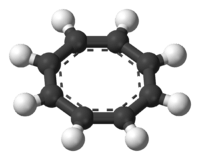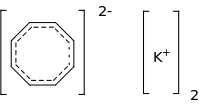Dipotassium cyclooctatetraenide
Dipotassium cyclooctatetraenide, sometimes abbreviated K2COT, is an organopotassium compound with the formula K2C8H8. It is a brown solid that is used as a precursor to cyclooctatetraenide complexes, such as uranocene (U(C8H8)2). Analogs of K2C8H8 are known with ring substituents, with different alkali metals, and with various complexants.

 | |
| Names | |
|---|---|
| IUPAC name
dipotassium cycloocatetraenediide | |
| Identifiers | |
3D model (JSmol) |
|
| ChemSpider | |
| |
| |
| Properties | |
| C8H8K2 | |
| Appearance | beige solid |
Except where otherwise noted, data are given for materials in their standard state (at 25 °C [77 °F], 100 kPa). | |
| Infobox references | |
Preparation and structure
Potassium cyclooctatetraenide is formed by the reaction of cyclooctatetraene with potassium metal:
- 2 K + C8H8 → K2C8H8
The reaction entails 2-electron reduction of the polyene and is accompanied by a color change from colorless to brown.[1]
The structure of K2(diglyme)C8H8 has been characterized by X-ray crystallography of the derivatives with diglyme complexed to the potassium cations. The C8H8 unit is planar with an average C-C distance of 1.40 A.[2]
References
- A. L Wayda (1990). "Cyclooctatetraene Lanthanide Complexes. Lu(C8H8Cl(thf) and Lu(C8H8)[o-C6H4CH2N(CH3)2(thf)". Inorganic Syntheses. 27: 150. doi:10.1002/9780470132586.ch28.
- J. H. Noordik, T. E. M. van den Hark, J. J. Mooij and A. A. K. Klaassen (1974). "Dipotassium(I) cyclooctatetraenide-1-methoxy-2-(2-methoxyethoxy)ethane". Acta Crystallogr B. 30 (30): 833–835. doi:10.1107/S0567740874003840.CS1 maint: multiple names: authors list (link)